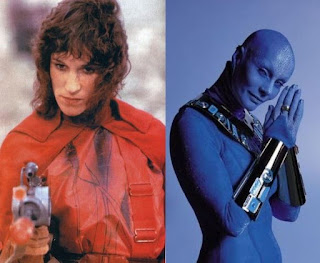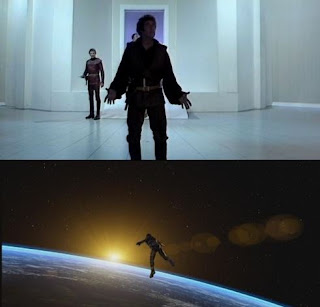This is a more casual article where I'll be talking about two of my favourite science fiction shows, which have a surprising amount in common. Obviously, since this is the Blake's 7 blog, it won't surprise you to learn that I'm a bit more biased towards the latter. So despite the title, this isn't going to be about me trying to figure which is the superior show. I'm just gonna be rambling about how they are similar, and how they are opposites. My purpose is to amuse, simply to amuse.
Let's start off with...
THE SIMILARITIES
#1. The main protagonist is a leather-toting gunslinger with a deteriorating mental state.
As the universe throws more and more spanners into their works, Kerr Avon and John Crichton overhaul their nerdy wardrobes and develop a more daring sense of fashion, well suited for the cover pages of whatever magazine gay alien handymen read. Both share a scientific background from Earth, albeit in different fields (Avon is a computer engineer, Crichton is a physicist), which plays a big part in their ability to survive perilous situations. Both learn to shoot first and ask questions later. Their love for weapons became rather worrisome, in fact. Crichton names his prized pulse pistol "Winona" and Avon starts hauling around giant pump-action shotguns (which, legend has it, was requested from the production team by actor Paul Darrow himself).
Expectedly, this gung-ho attitude comes at the cost of some brain cells, as both shows depict their lead gradually falling apart mentally, resulting in increasingly poor judgment with disastrous consequences for Avon and Crichton.
#2. The hothead with a noble heart.
Del Tarrant and Ka D'Argo both have a disreputable past, a penchant for treating friends poorly and a tendency to be overly argumentative. However, when push comes to shove, they're the people you'd want to be by your side as they're far too honourable to consider abandoning anyone, and know how to fight with the best of them. As their respective crew's more likable members die off, Tarrant and D'Argo step up to become the glue holding everything together.
They also occasionally assume command. In The Harvest of Kairos, Tarrant manages the ship in Avon's absence. He also takes charge in Power during the latter's imprisonment by the Hommiks, and leads the crew in defying Avon in Headhunter. In season 4 of Farscape, D'Argo is voted captain of his crew.
#3. The warrior telepath.
Cally and Zotoh Zhaan are both freedom fighters by choice and empathic by nature, with a natural ability to connect with the minds of others (and with their own race in particular). Their actions have led them to be outcasts from their home planet, but forge a new family with their respective crews, eventually becoming their heart and conscience. Cally and Zhaan are both tragically killed off in their shows' third season, leaving behind a void that's never truly filled.
#4. The insane military commander.
Both crews are hunted by a black leather-wearing madman with a personal chip on his shoulder regarding the main protagonist. They also both end up turning against their respective organisations, going fully renegade and growing to understand the flaws of their background whilst still embracing certain aspects of their military discipline. They both die trying to destroy a powerful resource created by said organisations(Star One/Talyn).
#5. The living ship carrying escaped prisoners from a dictatorial regime.
Both the Liberator and Moya are powerful, fast ships of a biological design. They serve as the main home and protection of a group of criminals on the run from a militaristic empire. The Liberator and Moya also share noticeable design similarities, such as an overall brownish colour scheme, a stationary interface with an enigmatic and impartial personality (Zen/Pilot) and a mysterious alien origin.
#6. The galactic empire.
The Federation and the Peacekeepers originate from the planet Earth, and were both once created for noble reasons. But corruption has turned them into an unforgiving, authoritarian nightmare and the main enemy for our crews. A single defector from both ends up joining the crews(Aeryn Sun/Del Tarrant). Despite being the primary antagonists, both the Liberator and Moya crews have to join up with them eventually to deal with a larger alien threat, the Andromedans and the Scarrans respectively. These conflicts end up weakening the Federation/Peacekeepers, giving the crews a chance to breathe later in the series.
#7. The femme fatale with a thing for our hero.
Obvious physical characteristics aside, Supreme Commander Servalan and Commandant Grayza are essentially the same type of person: a high-ranking leader in the enemy's hierarchy, who advances through the ranks via a combination of feminine wiles and genuine strategy, and whose ambition is boundless.
Both Servalan and Grayza eventually set their sights on the main protagonist, hoping to seduce them to gain access to a powerful weapon (the Orac computer/wormhole formulas) that would make them invincible. It's also hinted that they're somewhat vulnerable deep down. Both attempt to have children at some point, which affects their decisionmaking.
#8. Four seasons.
Blake's 7 and Farscape both lasted four years, with some minor similarities in their structures. Season 1 is introductory and somewhat distant from what the show later became. Season 2 is arguably the most iconic. Season 3 is generally well-received and season 4 is the black sheep of the family.
#9. The central relationship.
Both shows are anchored by two frenemies (Blake and Avon/Crichton and Scorpius) who are matched in intellect, but confounded by each other's ideology. Their interactions are indisputably the best part of each series, as both have a very understandable mindset that they refuse to break from, are played by terrific actors and develop to pick up on certain aspects of the other. Blake's 7 and Farscape could lose almost anything and still be good, but it couldn't afford to lose them.
#10. The MacGuffin.
Orac and wormholes have technically nothing in common, but the shows utilise them in exactly the same way. At the end of the first season of Blake's 7, the crew pick up a unique, all-powerful computer that enables them to accomplish feats that would've been entirely impossible without it, at the price of being hunted for it for the rest of the series.
At the end of the first season of Farscape, an alien race grants Crichton the unique ability to create and manipulate wormholes, which is used to accomplish feats that would've been entirely impossible without the knowledge, at the price of being hunted for it for the rest of the series.
Both MacGuffins span the entirety of the series. It's also worth noting that both of the franchises' sequels (the miniseries Peacekeeper Wars and book trilogy Lucifer respectively) feature these MacGuffins as a primary plot point.
DIFFERENCES
#1. The humor.
Blake's 7 has a deeply nihilistic sense of humor - even its most openly comedic episodes are generally based around something terrible happening or the threat of something terrible happening. Farscape, on the other hand, is more wholesome and willing to have fun for the sake of it. This probably comes down to the difference in protagonists. Blake, though idealistic, takes his crusade extremely seriously and is often too focused on trying to get something done to have fun. Avon is cynical to the extreme. Crichton, on the other hand, is depicted as being very optimistic and goodhearted in an old-fashioned American sort of way, often playing the fool or just plain being the fool.
#2. The ending.
As I said, Blake's 7 is a nihilistic show and it ends in one of the darkest way a show can end - with everybody dying. Whilst a few people pass away in Farscape's explosive climax as well, it is balanced by the birth of new life, and a bright future that appears over the horizon.
#3. The mission.
Although Blake's 7 was no stranger to variety, it mainly keeps the audience's focus with an overarching storyline of defeating the Federation. The crew in Farscape, however, have no such grand cause. The audience are hooked on Crichton's attempts to simply return home, and later to cut a deal that would force all major political powers in the galaxy to leave him and his family alone. But it's no bigger than any other Moya crewmember's personal objective. This allows Farscape's crew to feel like more of an ensemble and less like a monomaniac's group of eccentric goons.
#4. Production differences.
Despite both shows being four seasons long, Farscape has nearly twice as many episodes (especially when counting the miniseries). And then of course there's the obvious fact that Farscape was created twenty years later, with much more money to throw around. Special effects, camerawork, costuming, makeup, internal consistency are all of a significantly higher quality. It aims to be cinematic as opposed to a theatrical television programme like Blake's 7.
#5. Romance.
Blake's 7 likes to indulge in sexual innuendo from time to time, but never goes anywhere beyond that due to the restrictions of the time. Furthermore, any relationships concerning main characters never lasted beyond an episode (aside from possibly Avon and Anna Grant, but that wasn't onscreen).
Farscape is just plain horny lol. The characters frell like rabbits, and engage in long-running romantic melodramas with each other.
#6. Aliens.
Farscape, enjoying the attention of Jim Henson's Creature Shop, featured a wide plethora of alien races during its time, to the point where Crichton was often accused of being a Peacekeeper since they were the only race to look like humans (and are later revealed to be an offshoot).
Blake's 7 had pennies in the budget, so the galaxy is empty, populated by various colonies from Earth that have evolved into vastly separate societies. It is even widely believed that all sapient life originated from Earth. This turns out to be not the case, but they're not too far off, as only three truly alien species are encountered during the entire show's run: Zil's parasitic race from Trial, the difficult-to-love Andromedans from Star One and the strange alien Queen from Sarcophagus. Everybody else is either some genetic experiment, unintelligent or just conveniently looks human.


















No comments:
Post a Comment